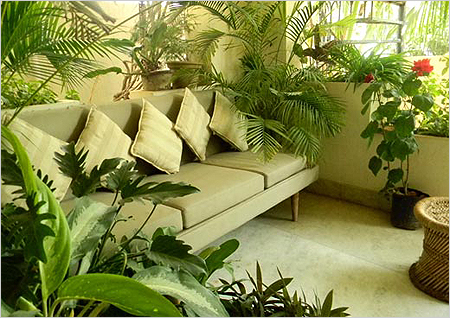Air Humidity for Indoor Plants
Many of our favorite indoor plants originate from the tropics. In their natural habitat, they thrive under the canopy of humid tropical forests with humidity levels ranging from 90% to 100%.
However, in typical apartments, especially during the winter heating season, humidity is much lower (around 30%-40%), which isn't ideal for plants. Nevertheless, most of them are quite adaptable and manage reasonably well in domestic conditions. It's important to remember that plants transpire water through their leaves when they're watered, which increases the overall humidity of the room. For example, a cyperus plant absorbs about a liter of water per day, but only two percent of this liquid is assimilated by the plant, while the rest is evaporated back into the air. That's nature's own humidifier!

But excessively dry air is a problem. For many moisture-loving tropical plants, dry air is detrimental. They exhibit yellowing and drying of leaf tips, bud drop, cessation of flowering, and rapid decline.
Air humidity needs to be increased for plants. However, before addressing this, consider that besides plants, there are also people living in the apartment.
What's the optimal humidity for humans?
For most people, the optimal relative humidity ranges from 45% to 55% at temperatures of 18-24°C. A hygrometer is used to measure humidity and is relatively inexpensive.
Too dry air increases the risk of respiratory infections and throat irritation, leading to sneezing.
Excessively humid air is also uncomfortable for many people— not everyone feels comfortable in a greenhouse. But the biggest danger of excess humidity is mold. It can appear on plants or in potting soil. Allergic reactions to mold are among the most severe.
If your apartment has normal humidity levels for humans, artificially increasing it is unnecessary; occasional spraying of plants is sufficient.

What's the optimal humidity for plants?
For tropical indoor plants, the ideal humidity level is 60–80%. Maintaining such a level indoors is challenging. Most homes have humidity levels of 60–40%, which is suitable for plants that easily adapt to such conditions.
If humidity is below 40%, it's too dry for all plants except cacti and succulents.
Common Plant Moisture Problems
There are general signs that low or high humidity may be the cause:
Too dry air:
- Leaves turn brown at the tips.
- The edges of the leaves turn yellow.
- Flowers quickly dry out and die.
- Leaves dry out and wrinkle.
Air humidity is too high:
- Gray mold appears on leaves and substrate.
- Leaves and stems begin to show signs of rot.
Do you need to increase humidity for plant comfort?
If your home is spacious enough to accommodate a winter garden or a green relaxation area, excessive humidity is not a significant concern.
A small apartment dictates its conditions—before worrying about creating a humid climate for plants, consider how you'll live in it. Analyze the situation and use common sense.

How to increase air humidity?
When the air is too dry, consider one of the following methods to increase humidity, which is beneficial for both humans and plants.
- Purchase an air humidifier. Humidifiers come in various types. The simplest is a fountain-style humidifier that releases and evaporates water. Steam humidifiers generate steam by heating and evaporating water. Ultrasonic humidifiers transform liquid into vapor using ultrasound. High-quality humidifiers come with a humidity sensor and shut off when the humidity exceeds a set limit.
- Buy an aquarium with decorative fish. An aquarium fits naturally into the green area of the apartment. Nearby plants will feel much better. An aquarium significantly increases indoor humidity naturally, but it requires care.
- Create a green corner in your home. Group indoor plants together. Choose moisture-loving plants that require frequent and abundant watering, such as ivy, certain ferns, and tradescantia. Buy "lucky bamboo," which can be kept in water indefinitely. Additionally, include several large-leaved plants as they are the best at humidifying the air—such as monsteras, various ficus varieties, and fatsia. These plants constantly release moisture, day and night, eliminating the need to switch on/off, monitor the safety of electrical appliances, etc.
- Use gravel trays. Placing plants on a tray filled with gravel or small rocks covered with water is an excellent way to improve humidity. If the air is dry, water evaporates quickly; if humidity increases, evaporation slows down. The tray consists of small gravel or rocks covered with water. The water should be slightly below the top of the gravel or rocks to prevent the plant from absorbing water and ensure good aeration. You may want to purchase a special plant tray, which is inexpensive.


In conclusion, if it's raining outside, snow is melting, or morning mist settles on the grass, don't make your life difficult—simply open the window and ventilate your home. It's beneficial for both you and your indoor plants.




